Everything You Need To Know About Gharials

Gharials are among the most fascinating yet critically endangered reptiles on our planet. These unique crocodilians with their distinctive thin snouts have roamed Earth’s rivers for millions of years.
Unfortunately, with fewer than 1,000 adult gharials left in the wild, understanding these remarkable creatures has never been more important for their survival.
1. What Makes Gharials So Unique: The Crocodilian With A Twist

The gharial stands out with its incredibly narrow snout that ends in a bulbous growth called a ‘ghara’ in males. This bizarre nose-bulb actually amplifies sounds during mating season!
Unlike their crocodile cousins, gharials can’t walk well on land. Their weak legs mean they spend almost their entire lives in water, perfectly adapted for swimming and catching slippery fish.
2. Where Do Gharials Live? The Secret World Of River-Dwelling Reptiles

Flowing through northern India and Nepal, the Ganges, Chambal, and Brahmaputra rivers form the gharial’s natural kingdom. These reptiles prefer deep, fast-moving waters with sandbanks for basking and nesting.
Historically, gharials roamed rivers across the Indian subcontinent, but today they’re confined to just 2% of their former range—a tragic shrinking of their world.
3. Long Snouts, Big Impact: Gharial’s Physical Features Explained

Gharials grow impressively large—males can reach 20 feet long, outmeasuring many other crocodilians! Their needle-thin snouts contain up to 110 interlocking teeth specialized for snatching fish.
Their olive-brown bodies blend perfectly with riverbed mud. Webbed rear feet make them excellent swimmers, while their powerful tails propel them through water with surprising speed and agility.
4. What’s On The Menu For These Fish-Lovers?

Fish make up nearly 100% of the gharial diet—they’re nature’s perfect fishing machines! Their specialized jaws can snap sideways through water with lightning speed, capturing slippery prey in their needle-like teeth.
Young gharials start with insects and small frogs before graduating to fish. Unlike other crocodilians, they physically cannot consume large mammals due to their narrow snouts.
5. Baby Gharials And The Struggle To Reproduce
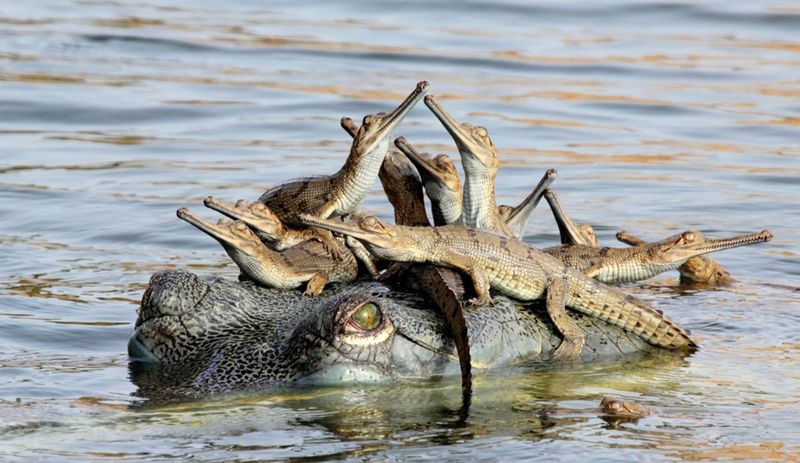
Female gharials dig sandy nests where they lay 20-95 eggs during the dry season. The scorching sun incubates these eggs for about 70 days before hatchlings emerge, each barely 15 inches long.
Mom gharials show surprising tenderness, carrying newly hatched babies to water in their mouths. Sadly, only 1% of hatchlings survive to adulthood—facing threats from predators, flooding, and human disturbance.
6. Gharials On The Brink: Why This Ancient Species Is Endangered

From thousands roaming Asian rivers to fewer than 1,000 adults today—gharials face extinction primarily due to human activities. Dam construction has fragmented their habitat, while fishing nets entangle and drown them.
Sand mining destroys crucial nesting beaches. River pollution from agricultural runoff and industrial waste poisons their waters. Hunting for traditional medicine—using their snouts as supposed aphrodisiacs—has further decimated populations.
7. How Conservationists Save Gharials

Hope flickers through dedicated breeding centers in India and Nepal where scientists carefully raise gharial hatchlings until they’re large enough to avoid predation. Over 5,000 captive-raised gharials have been released back into protected rivers!
Community-based conservation engages local fishermen as “gharial guardians.” Protected areas like Chambal Sanctuary create safe havens where these ancient reptiles can recover without human interference.
8. Gharial Vs. Crocodile
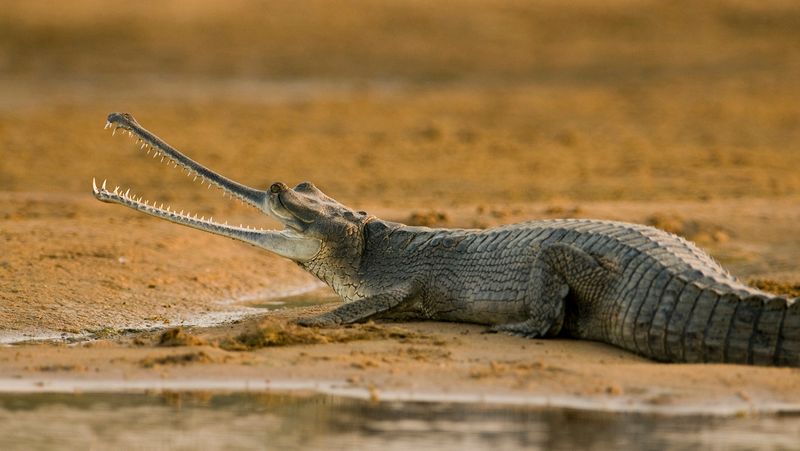
Spot the difference! While crocodiles sport broad, powerful jaws perfect for taking down large prey, gharials have evolved super-thin snouts exclusively for fish-catching. Crocs can gallop on land; gharials awkwardly drag themselves.
Temperament-wise, crocodiles can be notoriously aggressive toward humans. Gharials, despite their prehistoric appearance, are surprisingly shy and pose virtually no threat to people—they physically cannot eat us!
9. Gharials And Their River Ecosystem
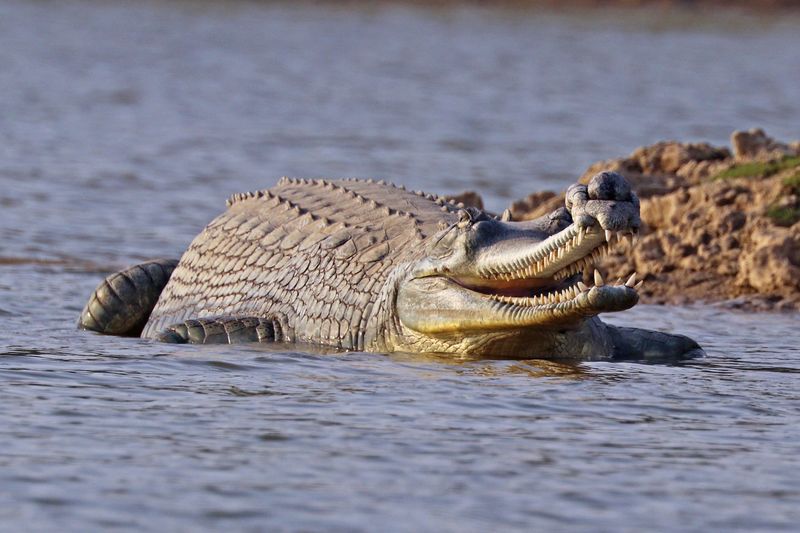
As apex predators, gharials regulate fish populations, preventing any single species from dominating river ecosystems. Their presence indicates healthy, clean waterways—making them living water quality indicators.
Their nesting activities churn riverbanks, aerating soil and creating microhabitats for other species. Even their droppings fertilize aquatic plants! These living fossils maintain ecological balance in ways we’re only beginning to understand.
10. Sensory Superpowers: How Gharials Navigate Their World
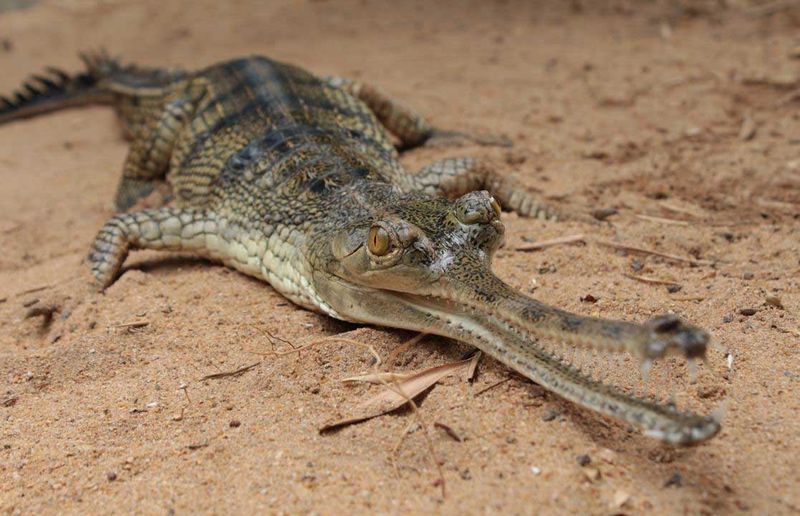
Those bumps along a gharial’s jaws? They’re pressure sensors detecting the tiniest fish movements underwater—like having built-in sonar! Their excellent vision works both above and below water thanks to a third eyelid that acts as swimming goggles.
The male’s ghara (nose bulb) contains special chambers that amplify vocalizations during mating season. Females can hear these booming calls from remarkable distances, guiding them to potential mates across murky waters.
11. The Truth About Gharials’ Temperament

Despite their fearsome appearance, gharials are the gentle giants of the crocodilian world. Their narrow jaws physically prevent them from attacking large prey—including humans! No confirmed gharial attacks on people exist.
When approached, these shy creatures quickly retreat underwater rather than confront threats. Ironically, their scary looks might be their greatest defense, keeping potential predators and humans at a respectful distance.
12. The Future Of The Gharial: Hope For This Ancient Reptile
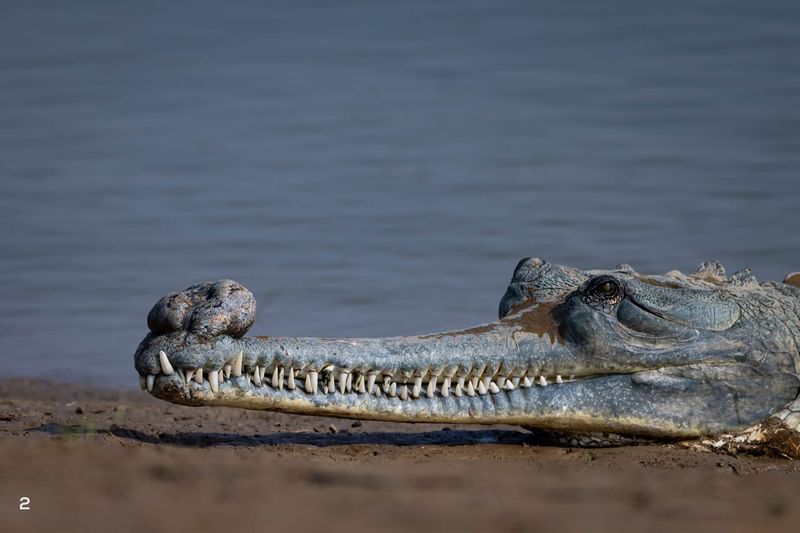
Against all odds, gharial populations have stabilized in several protected areas. The National Chambal Sanctuary has seen numbers increase from 107 to over 500 gharials—proving recovery is possible with dedicated conservation.
Cutting-edge satellite tracking now monitors released gharials, providing crucial data. International cooperation between India, Nepal, and global conservation groups offers new funding and expertise to save these living dinosaurs from extinction.






